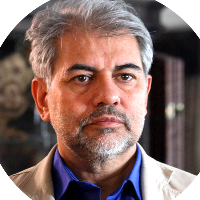The Stylistic Similarities in Royal and Folk Portraits of Qajar Painting
The human figure has been a common subject of visual arts. Many cultures represent human figures in different ways, giving rise to objects that have been made using a huge variety of materials and manufacturing techniques. Some figures appear in realistic execution and others in stylized or abstract one. Comparing objects made by different artists of the same culture reveals how figurative art often reflects cultural influences. People of different cultures choose to portray the human body in different ways. Such figures often exhibit not only different styles but also different poses. The posture of a figure or its stylized presentation may mean something significant to people of a particular culture, or it may reflect the personal preference of the artist or the patron. In different cultures the human body is treated in varied ways as a means of cultural expression. One of the important periods in the history of Persian painting is the Qajar era in which human figure in arts would take a significant position. Most famous of the Qajar artworks are the portraits that were painted of various Persian Shahs and courtiers. Qajar painting contains various themes the best of which is manifested in the Royal Portraiture. The prominent artworks of this school are those of rulers and princes mostly executed in certain principles. Such works from the court realm could be generally divided into three categories: standing, sitting and equestrian. Here it should be noted that the sitting portraits are of particular characteristics from the viewpoint of physical structures and poses. This matter later would be manifested in the field of folk portraiture and painting as well. The manifestation of the royal portraits in another field of portraiture, i.e. folk (sometimes called “non-royal” or even “low”) art, brings up some questions as follow: What are thestylistic similarities in the royal portraits of the Qajar period in comparison to those of the folk paintings? How are the postures and gestures of figures, especially in sitting poses, reflected? The results of the research demonstrate that Qajar courtly and folk portraitures, with human figure and idealization factor in the center, are indicative of a single style manifested in two themes. Here, figures are personalized and the subject stabilizes its presence on the work. In folk portraiture, sitting poses, mostly kneeled, are distinguished by characteristics such as the subject's distinction, individualization and personalization, while other courtly features such as muscled arms, broad chest and slim waist are left out so that the kingly aspects of works decrease. Furthermore, Qajar portraiture offers a new definition of the human form and figure in painting. In the present article, two main fields, i.e. royal portraiture and the religious folk art, have been studied. Meanwhile, the poses, postures, positions and physiques of portraits in each field have been analyzed. For this purpose, the structures and visual features of the works have been categorized. Then, the continuation of the royal style and its manifestation in folk portraits and other non-royal works has been examined.
- حق عضویت دریافتی صرف حمایت از نشریات عضو و نگهداری، تکمیل و توسعه مگیران میشود.
- پرداخت حق اشتراک و دانلود مقالات اجازه بازنشر آن در سایر رسانههای چاپی و دیجیتال را به کاربر نمیدهد.



